Combat "Hips"
> Mi-8TV (1974)
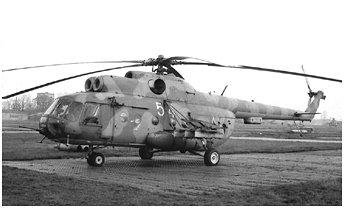
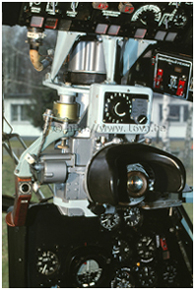 A second version, also referred to as Mi-8TV, appeared in 1974. The designation "TV" of the model described on the previous page had indeed not been officially
attributed by the Mil' OKB. It was rather an informal designation that indicated Mi-8T with armament. The new version had a larger carrying capacity thanks
to two lateral external frames, each accommodating three weapon racks. Six UB-32A-24 rocket pods (with 32 S-5 rockets per pod), various bombs (from 50 to 500kg)
or ZB-500 napalm containers could be hung under those racks. The maximum load was limited to 1500 kg. In addition, four 9M17P Falanga (Phalanx) antitank missiles,
alias AT-2C "Swatter-C," slid on the 2P32M rails mounted in pairs at the end of the frames. Thus, the regiments equipped with Mi-24A and later Mi-24D, possessed a
higher antitank capability thanks to the Mi-8TV that were assigned to them. Also, Mi-8 and Mi-24 were using the same types of missiles
(see > The Mi-24, part 1).
Moreover, an Afanas'yev 12.7mm-caliber A-12.7 machine gun was mounted under the chin of the Mi-8TV cockpit. That weapon with a provision for 700 rounds of ammunition
was served by the flight engineer. Besides the PKV and OPB-1R sights of the Mi-8T, the Mi-8TV co-pilot had an additional 9Sh121-01 sight and a joystick to
fire and control the antitank missiles. The guiding antenna of the latter was attached just behind the cockpit, on the top right side of the fuselage
(> Photo).
A second version, also referred to as Mi-8TV, appeared in 1974. The designation "TV" of the model described on the previous page had indeed not been officially
attributed by the Mil' OKB. It was rather an informal designation that indicated Mi-8T with armament. The new version had a larger carrying capacity thanks
to two lateral external frames, each accommodating three weapon racks. Six UB-32A-24 rocket pods (with 32 S-5 rockets per pod), various bombs (from 50 to 500kg)
or ZB-500 napalm containers could be hung under those racks. The maximum load was limited to 1500 kg. In addition, four 9M17P Falanga (Phalanx) antitank missiles,
alias AT-2C "Swatter-C," slid on the 2P32M rails mounted in pairs at the end of the frames. Thus, the regiments equipped with Mi-24A and later Mi-24D, possessed a
higher antitank capability thanks to the Mi-8TV that were assigned to them. Also, Mi-8 and Mi-24 were using the same types of missiles
(see > The Mi-24, part 1).
Moreover, an Afanas'yev 12.7mm-caliber A-12.7 machine gun was mounted under the chin of the Mi-8TV cockpit. That weapon with a provision for 700 rounds of ammunition
was served by the flight engineer. Besides the PKV and OPB-1R sights of the Mi-8T, the Mi-8TV co-pilot had an additional 9Sh121-01 sight and a joystick to
fire and control the antitank missiles. The guiding antenna of the latter was attached just behind the cockpit, on the top right side of the fuselage
(> Photo).
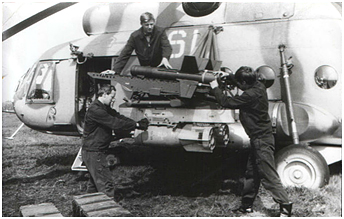
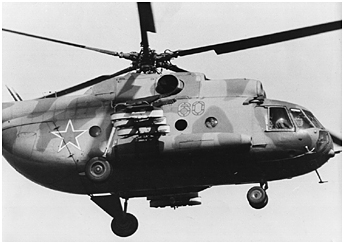 This "Hip" version also was equipped with an S3M (SPO-10) radar warning detector, its small spherical antenna fairings located on both sides of the nose and the tail.
Mi-8T and TV carried a SRO-2M "Khrom" IFF transponder recognizable by its three small antennas of decreasing length located under the nose and tail of the helicopter.
As can be observed on some pictures, some Mi-8TVs were updated with the SRO-1P "Parol" system whose antennas were triangular.
Officially designated Mi-8TV (was this the case at unit level?), the latter could not embark troops when it carried its full complement of weapons.
The new range of armament also justified a new NATO identification code for this version, namely "Hip-E".
This "Hip" version also was equipped with an S3M (SPO-10) radar warning detector, its small spherical antenna fairings located on both sides of the nose and the tail.
Mi-8T and TV carried a SRO-2M "Khrom" IFF transponder recognizable by its three small antennas of decreasing length located under the nose and tail of the helicopter.
As can be observed on some pictures, some Mi-8TVs were updated with the SRO-1P "Parol" system whose antennas were triangular.
Officially designated Mi-8TV (was this the case at unit level?), the latter could not embark troops when it carried its full complement of weapons.
The new range of armament also justified a new NATO identification code for this version, namely "Hip-E".
The Mi-8TV equipped different types of units in the GDR, whether detachments, squadrons or regiments (see > The Armeyskaya Aviatsiya in Germany).
The "Hip-C" and / or "Hip-E" (precise version unknown) flew within separate detachments (OVO) and then separate fire support squadrons (OVE OP).
This last type of unit, which appeared in the mid-1980s, would have had its first group equipped with eight Mi-24 and its second group with six Mi-8.
The third group consisted of two Mi-8VzPU flying command posts, as well as four special Mi-24s (two R and two K) (1).
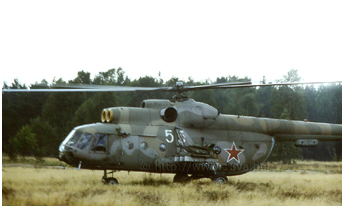
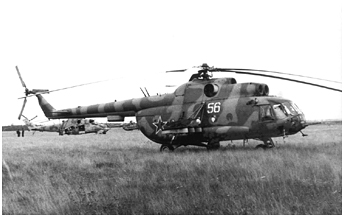 When they were assigned to separate combat helicopter regiments (OBVP) equipped with Mi-24s, the Mi-8s were part of the third squadron whereas
the first and the second squadrons were flying the "Hinds." Each squadron had 20 helicopters on strength, divided into 5 flights (zveno).
The third squadron was generally composed of eight Mi-8T and eight Mi-8TV. The remainder of the squadron included specialized Mi-8s, such as Mi-8VzPU
or Mi-9 command posts (two helicopters) and two unidentified variants. The separate combat and control helicopter regiments (OVP BU) also were composed
of three squadrons mixing Mi-8s and Mi-24s. Thus, each of the squadrons had two Mi-24 flights and two Mi-8 flights on strength in addition to two "Hip"
command posts and four specialized Mi-24s (K and R).
Finally, each Army had a separate squadron of combat and control helicopters (OVE BU), composed of two to six "Hip-C" alongside Mi-8PPA, Mi-2T, Mi-24K and R and
Mi-6 command posts. In any case, the number of helicopters could vary from one unit to another depending on the time frame.
When they were assigned to separate combat helicopter regiments (OBVP) equipped with Mi-24s, the Mi-8s were part of the third squadron whereas
the first and the second squadrons were flying the "Hinds." Each squadron had 20 helicopters on strength, divided into 5 flights (zveno).
The third squadron was generally composed of eight Mi-8T and eight Mi-8TV. The remainder of the squadron included specialized Mi-8s, such as Mi-8VzPU
or Mi-9 command posts (two helicopters) and two unidentified variants. The separate combat and control helicopter regiments (OVP BU) also were composed
of three squadrons mixing Mi-8s and Mi-24s. Thus, each of the squadrons had two Mi-24 flights and two Mi-8 flights on strength in addition to two "Hip"
command posts and four specialized Mi-24s (K and R).
Finally, each Army had a separate squadron of combat and control helicopters (OVE BU), composed of two to six "Hip-C" alongside Mi-8PPA, Mi-2T, Mi-24K and R and
Mi-6 command posts. In any case, the number of helicopters could vary from one unit to another depending on the time frame.
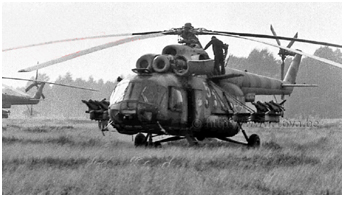 In the early 1990s, very few Mi-8TV remained in the GDR. The process of replacing them with Mi-8MT and Mi-8MTV-2 was generally only partial;
the third squadron of combat helicopter regiments were disappearing or had its strength reduced. This strength reduction also was a consequence of the withdrawal from Germany of all
Mi-8 electronic versions. Thus, the latter helicopters and the Mi-8TV had completely disappeared from the German skies in 1992. It should be noted that the "Hip-E"
was too heavy when carrying weapons and, even though its replacements had no antitank capability, its 9M17P missiles were outdated, especially compared to the 9M114 "Shturm-V"
employed by the numerous Mi-24V and P present in East Germany.
In the early 1990s, very few Mi-8TV remained in the GDR. The process of replacing them with Mi-8MT and Mi-8MTV-2 was generally only partial;
the third squadron of combat helicopter regiments were disappearing or had its strength reduced. This strength reduction also was a consequence of the withdrawal from Germany of all
Mi-8 electronic versions. Thus, the latter helicopters and the Mi-8TV had completely disappeared from the German skies in 1992. It should be noted that the "Hip-E"
was too heavy when carrying weapons and, even though its replacements had no antitank capability, its 9M17P missiles were outdated, especially compared to the 9M114 "Shturm-V"
employed by the numerous Mi-24V and P present in East Germany.
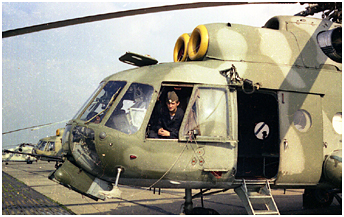
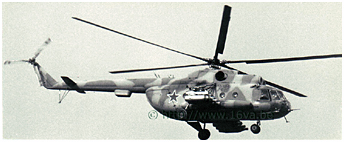 We will conclude by recalling that the export version of the Mi-8TV "Hip-E" was equipped to carry up to six 9M14M Malyutka (Baby, alias AT-3 "Sagger-A")
smaller anti-tank missiles instead of the four Falanga on the Soviet version.
This version, by any logic, was called Mi-8TVK (K for Kommercheskiy - commercial) and was named "Hip-F" in the NATO nomenclature.
The GDR used this version. However, the technical documentation provided in Russian to the East German forces clearly stated that these were Mi-8TB models.
We would therefore be faced with two different export designations - perhaps born of confusion or maskirovka - for one and the same machine.
We will conclude by recalling that the export version of the Mi-8TV "Hip-E" was equipped to carry up to six 9M14M Malyutka (Baby, alias AT-3 "Sagger-A")
smaller anti-tank missiles instead of the four Falanga on the Soviet version.
This version, by any logic, was called Mi-8TVK (K for Kommercheskiy - commercial) and was named "Hip-F" in the NATO nomenclature.
The GDR used this version. However, the technical documentation provided in Russian to the East German forces clearly stated that these were Mi-8TB models.
We would therefore be faced with two different export designations - perhaps born of confusion or maskirovka - for one and the same machine.
Particular "Hips"
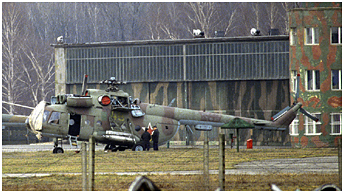
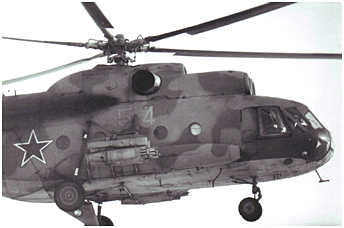 Mi-8s were regularly observed patrolling along the inter-German border. Among these were Mi-8TARK versions. Two different interpretations of the TARK designation exist:
Televizionnyy Artilleriyskiy Razvedchik-Korrektirovshchik (TV artillery spotter) and Televizionniy Aviatsionnyy Razvedchik-Korrektirovshchik (airborne TV artillery spotter).
These helicopters would have been designated Mi-8TG (not to be confused with the model from the early 1990s operating with liquid gas) by the military. The fall of the Berlin
wall made it possible to discover these particular machines. However, on the one hand, what could be documented did not correspond exactly to a part of the designation
(the word "television" was not justified) and, on the other hand, to the limited documentation available on the Russian side. It is likely that this Mi-8 variant could be
configured differently depending on the missions to be performed. The model identified in the GDR in the early 1990s was equipped with a 1000mm
AFA42/100 camera or a 1300mm A-87P camera, both of which were mounted
obliquely behind the front cabin window located on the right side. The interior layout of the cabin made it possible to develop photographs
during flight. A helicopter photographed during an open day at Mahlwinkel in 1992 also had a camera mounted on the floor of the rear cargo hold, pointing down through the ventral
opening of the winch. An AFA 42/100 camera was also mounted; however, the rest of the equipment had been dismantled. The border observation mission was obviously abandoned when the
GDR ceased to exist and the Mi-8TARK airframes were restored to the standards of the transport and assault Mi-8Ts. Also, the Mi-8TARK had already been replaced by the Mi-24K in its
role of artillery fire "corrector." Some Russian descriptions of the Mi-8TARK present a rather different helicopter. The latter carried a television reconnaissance suite for
transmitting images in real time to the command posts via relay equipment in mounted pods (interior or exterior?). The cameras were mounted behind open window hatches and were
remotely controlled from a PNS-3 attitude and heading reference system. One of the cameras was used to provide a small-scale image when shooting from low altitudes (at least 200m),
the other for a large-scale survey with a minimum altitude of 1000m. The image was displayed on the screen of a VKS-121 panel operated by an additional crewmember (to be able to
visually monitor the surroundings; he replaced the flight engineer in the cockpit and the engineer continued the flight standing in the doorway and monitoring his instruments).
Particular attention during the operation of the television system had to be paid to keeping the optics clean - dust, dirt and insects affected image quality.
It should be noted (with all reservations) that there would have been a TARK-1 version adapted to the Mi-4, while the TARK-2 package involved the Mi-8.
Mi-8s were regularly observed patrolling along the inter-German border. Among these were Mi-8TARK versions. Two different interpretations of the TARK designation exist:
Televizionnyy Artilleriyskiy Razvedchik-Korrektirovshchik (TV artillery spotter) and Televizionniy Aviatsionnyy Razvedchik-Korrektirovshchik (airborne TV artillery spotter).
These helicopters would have been designated Mi-8TG (not to be confused with the model from the early 1990s operating with liquid gas) by the military. The fall of the Berlin
wall made it possible to discover these particular machines. However, on the one hand, what could be documented did not correspond exactly to a part of the designation
(the word "television" was not justified) and, on the other hand, to the limited documentation available on the Russian side. It is likely that this Mi-8 variant could be
configured differently depending on the missions to be performed. The model identified in the GDR in the early 1990s was equipped with a 1000mm
AFA42/100 camera or a 1300mm A-87P camera, both of which were mounted
obliquely behind the front cabin window located on the right side. The interior layout of the cabin made it possible to develop photographs
during flight. A helicopter photographed during an open day at Mahlwinkel in 1992 also had a camera mounted on the floor of the rear cargo hold, pointing down through the ventral
opening of the winch. An AFA 42/100 camera was also mounted; however, the rest of the equipment had been dismantled. The border observation mission was obviously abandoned when the
GDR ceased to exist and the Mi-8TARK airframes were restored to the standards of the transport and assault Mi-8Ts. Also, the Mi-8TARK had already been replaced by the Mi-24K in its
role of artillery fire "corrector." Some Russian descriptions of the Mi-8TARK present a rather different helicopter. The latter carried a television reconnaissance suite for
transmitting images in real time to the command posts via relay equipment in mounted pods (interior or exterior?). The cameras were mounted behind open window hatches and were
remotely controlled from a PNS-3 attitude and heading reference system. One of the cameras was used to provide a small-scale image when shooting from low altitudes (at least 200m),
the other for a large-scale survey with a minimum altitude of 1000m. The image was displayed on the screen of a VKS-121 panel operated by an additional crewmember (to be able to
visually monitor the surroundings; he replaced the flight engineer in the cockpit and the engineer continued the flight standing in the doorway and monitoring his instruments).
Particular attention during the operation of the television system had to be paid to keeping the optics clean - dust, dirt and insects affected image quality.
It should be noted (with all reservations) that there would have been a TARK-1 version adapted to the Mi-4, while the TARK-2 package involved the Mi-8.
| Mi-8TARK Photos |
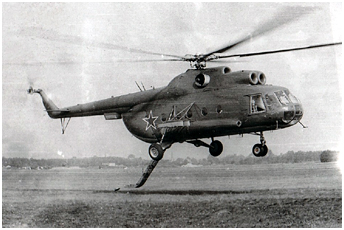
 Minelaying was another task for the Mi-8Ts. The VSM-1 system (Vozdushnaya Sistema Minerovaniya - Airborne Minelaying System) was a standard equipment for both the Mi-8T
and the Mi-8MT (> Photo of an Mi-8MT from Oranienburg). It consisted of four mine-filled containers attached to the weapon pylons
(> Link illustrating a Mi-8MTV-2 with these containers). Each container was
loaded with 29 KSO-1 cassettes filled with mines. The total number of mines carried depended on their type: 7624 PFM-1S anti-personnel mines, 464 POM-2 fragmentation
anti-personnel mines or 116 PTM-3 antitank mines. There were also PDM-4 mines to hinder an amphibious assault. The mines were sequentially ejected from a height of 20
to 100 meters by pyrotechnic charges and their dispersion was controlled from a panel mounted inside the cargo hold.
However, the carpet of mines that resulted was uneven. Nevertheless, this system had the advantage of allowing the mines release at high speed - up to 230 km/h for the
Mi-8MT - thus exposing the helicopter for a limited period of time to enemy fire. A Mi-8 could disperse nearly 8,000 mines in one minute, covering a strip of land 2 kilometers
long and 15-20 meters wide. The density of the minefield depended on the rate at which the mines were dropped and the altitude.
Minelaying was another task for the Mi-8Ts. The VSM-1 system (Vozdushnaya Sistema Minerovaniya - Airborne Minelaying System) was a standard equipment for both the Mi-8T
and the Mi-8MT (> Photo of an Mi-8MT from Oranienburg). It consisted of four mine-filled containers attached to the weapon pylons
(> Link illustrating a Mi-8MTV-2 with these containers). Each container was
loaded with 29 KSO-1 cassettes filled with mines. The total number of mines carried depended on their type: 7624 PFM-1S anti-personnel mines, 464 POM-2 fragmentation
anti-personnel mines or 116 PTM-3 antitank mines. There were also PDM-4 mines to hinder an amphibious assault. The mines were sequentially ejected from a height of 20
to 100 meters by pyrotechnic charges and their dispersion was controlled from a panel mounted inside the cargo hold.
However, the carpet of mines that resulted was uneven. Nevertheless, this system had the advantage of allowing the mines release at high speed - up to 230 km/h for the
Mi-8MT - thus exposing the helicopter for a limited period of time to enemy fire. A Mi-8 could disperse nearly 8,000 mines in one minute, covering a strip of land 2 kilometers
long and 15-20 meters wide. The density of the minefield depended on the rate at which the mines were dropped and the altitude.
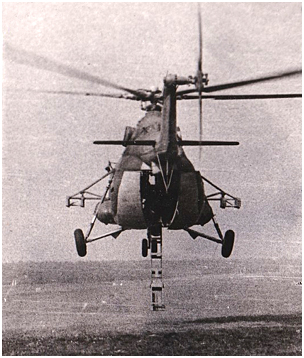 Une autre image du Mi-8T illustré ci-dessus, avec la rampe du système VMR-1 abaissée. © DR.
Une autre image du Mi-8T illustré ci-dessus, avec la rampe du système VMR-1 abaissée. © DR.
Another image of the Mi-8T illustrated above, with the ramp of the VMR-1 minelaying system in working position. © DR.
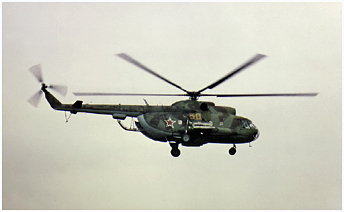 Another anti-tank minelaying system called "Dozhd" (rain) was developed in 1974-1975 for the Mi-8Ts. Such "Hips" were then designated Mi-8AV (in 1978,
the system was adapted to the dispersion of anti-personnel mines - the helicopters were then designated Mi-8AD). This VMR-1 complex (Vertoletnyy Minoraskladchik -
Helicopter-borne minelayer) installed in the cargo hold made it possible to deposit mines in flight at ground level via a toboggan-like ramp deployed at the rear between
the open clamshell doors. This device was raised under the tail boom when not in use, making it impossible to completely close the clamshell doors. The VMR-1 complex for 56 mines -
much larger than those used with the VSM system - was manual: two operators had to deposit the mines on a conveyer with rollers inside the cargo compartment. The mines then moved
along the latter, leading to the toboggan deployed downwards (an operator sometimes had to push the mines manually between the end of the conveyer and the toboggan), while
the helicopter was flying between 20 and 50 km/h from a maximum height of 3 meters. It should be noted that the VMR-1 was also used on Mi-4s.
Another anti-tank minelaying system called "Dozhd" (rain) was developed in 1974-1975 for the Mi-8Ts. Such "Hips" were then designated Mi-8AV (in 1978,
the system was adapted to the dispersion of anti-personnel mines - the helicopters were then designated Mi-8AD). This VMR-1 complex (Vertoletnyy Minoraskladchik -
Helicopter-borne minelayer) installed in the cargo hold made it possible to deposit mines in flight at ground level via a toboggan-like ramp deployed at the rear between
the open clamshell doors. This device was raised under the tail boom when not in use, making it impossible to completely close the clamshell doors. The VMR-1 complex for 56 mines -
much larger than those used with the VSM system - was manual: two operators had to deposit the mines on a conveyer with rollers inside the cargo compartment. The mines then moved
along the latter, leading to the toboggan deployed downwards (an operator sometimes had to push the mines manually between the end of the conveyer and the toboggan), while
the helicopter was flying between 20 and 50 km/h from a maximum height of 3 meters. It should be noted that the VMR-1 was also used on Mi-4s.
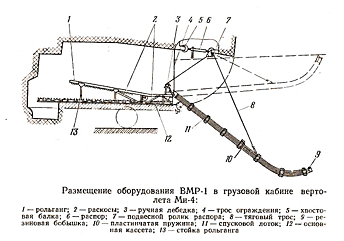
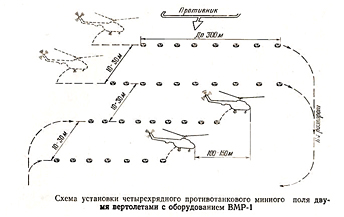 The VMR-2 (> Link / Mi-8T NVA > Photo 1 -
Photo 2 - Photo 3)
that appeared during the mid-1980s was a more elaborate automated device that could
be adapted to the Mi-8T and Mi-8MT airframes.
Cassettes containing the mines installed at an angle of 50-60° released them onto a conveyor belt. Here, the ramp was much shorter; however, it still prevented
the closing of the cargo doors. It was possible to cover a strip of land 600-800 meters long, dropping mines (up to 200 depending on type) at an interval of
5.5-11 meters. The maximum drop altitude was increased to 200 meters, while the top speed could reach 160 km/h. Although the VMR-2 complex was efficient, loading
it with mines remained tedious.
The VMR-2 (> Link / Mi-8T NVA > Photo 1 -
Photo 2 - Photo 3)
that appeared during the mid-1980s was a more elaborate automated device that could
be adapted to the Mi-8T and Mi-8MT airframes.
Cassettes containing the mines installed at an angle of 50-60° released them onto a conveyor belt. Here, the ramp was much shorter; however, it still prevented
the closing of the cargo doors. It was possible to cover a strip of land 600-800 meters long, dropping mines (up to 200 depending on type) at an interval of
5.5-11 meters. The maximum drop altitude was increased to 200 meters, while the top speed could reach 160 km/h. Although the VMR-2 complex was efficient, loading
it with mines remained tedious.
Other variants or provisional adaptations of the Mi-8T airframes are also likely to have served within the GSFG. Among these, there certainly were
helicopters intended to lay smoke screens. Thus, we know that the Mi-8MT could be equipped with the "Flamingo" smoke system comprising four external
tanks containing the smoke liquid and, inside the cargo hold, two AI-8 auxiliary groups used to generate the smoke. There also was the "Lyunet" (lunette) smoke system
where smoke cartridges were carried inside four external pods. Specialized medical versions have also been
developed, such as the Mi-8MB designed to assist the victims of a nuclear attack, but we do not know if such models were deployed in the GDR. On the other hand,
the Mi-8TZ intended to refuel vehicles on the ground were probably used in East Germany. Also, let us mention the bort nomer 45 assigned to the 226.OSAP that,
according to unconfirmed rumors in the 1990s, was a TL (L for Labor) version equipped with the appropriate equipment in order to be able to analyze the black boxes of a
crashed aircraft (> Photo).
Finally, some versions of the Mi-8T more than likely having been operating in East Germany are almost totally unknown. So is the Mi-8VD,
an NBC reconnaissance helicopter that could have succeeded the Mi-2R (KhR), before the Mi-24R entered into service .
Flying Salons
> Mi-8 "Salon"
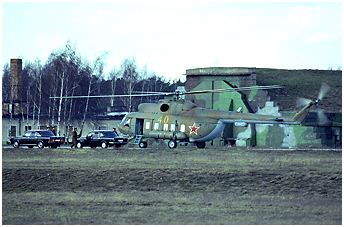
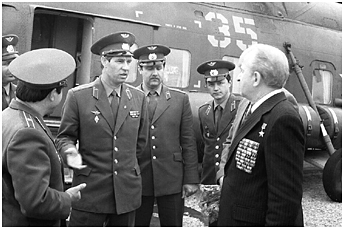 Some squadrons and independent regiments within Armeyskaya Aviatsiya, as well as the 226.OSAP and the 113.OSAE at Sperenberg subordinate to the 16.VA,
were equipped with a few helicopters in three other "Hip-C" variants or adaptations. The Mi-8PS (P for Passazhirskiy -
passengers, S for Salonaya komponovka - VIP)
with rectangular windows appeared in 1969 and was a derivative of the Mi-8P equipped with VIP interior fittings devoted to the transport of important passengers.
It had an adaptable communication suite based on the rank and value of its precious cargo. The complete designation of the Mi-8PS reflected the number of passengers
it could carry: PS-7, PS-9 or PS-11 for 7, 9 or 11 passengers, respectively. These helicopters were always equipped with large fuel tanks. The Mi-8PS with the rectangular
windows should not be confused with the Mi-8PS (Poyskovo Spasatel'niy) search and rescue version that appeared later in 1976.
Some squadrons and independent regiments within Armeyskaya Aviatsiya, as well as the 226.OSAP and the 113.OSAE at Sperenberg subordinate to the 16.VA,
were equipped with a few helicopters in three other "Hip-C" variants or adaptations. The Mi-8PS (P for Passazhirskiy -
passengers, S for Salonaya komponovka - VIP)
with rectangular windows appeared in 1969 and was a derivative of the Mi-8P equipped with VIP interior fittings devoted to the transport of important passengers.
It had an adaptable communication suite based on the rank and value of its precious cargo. The complete designation of the Mi-8PS reflected the number of passengers
it could carry: PS-7, PS-9 or PS-11 for 7, 9 or 11 passengers, respectively. These helicopters were always equipped with large fuel tanks. The Mi-8PS with the rectangular
windows should not be confused with the Mi-8PS (Poyskovo Spasatel'niy) search and rescue version that appeared later in 1976.
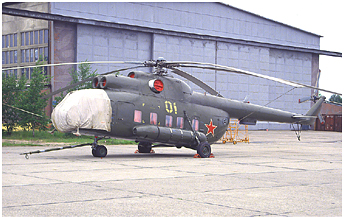
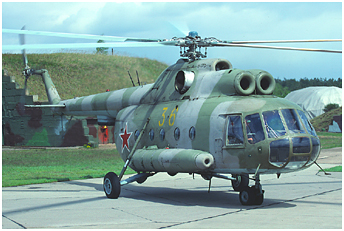 The Mi-8T and TV (1968) airframes could be equipped with seats and small tables to discreetly transport passengers such as unit commanders. These helicopters
might also have more elaborate communication equipment. Such Mi-8T called "Salon" also were on strength with combat units. Thus, during a visit to Werneuchen,
our escort told us that Mi-8T n°21 assigned to the 41.OVE BU armed with its classic rocket pods was a Mi-8 "Salon." To complicate (or should we say simplify?) the
identification of these different sub-versions, it seems that the Russians and, to a certain extent, a few countries of the former Warsaw Pact, call any "Hip" equipped
with some VIP fittings a Mi-8S whatever its version, be it a "Hip-C" or even a "Hip-H." Nevertheless, there was indeed a version officially designated Mi-8S. Externally
very similar to the Mi-8PS, this model did not have the same number of windows, but it could be easily identified by the heat exchanger of an air conditioning system mounted
on the left side forward of the fuel tank. In addition to a secure communications suite and large fuel tanks, this version was powered by more powerful 1700hp TV2-117F turbines.
Another feature was that it had a downward-hinged rather than the normal sliding side door, and integrated steps.
We will finally remark that all the Mi-8S and PS as well as the Mi-8T "Salon" that were observed in the GDR had the "Parol" IFF system.
The Mi-8T and TV (1968) airframes could be equipped with seats and small tables to discreetly transport passengers such as unit commanders. These helicopters
might also have more elaborate communication equipment. Such Mi-8T called "Salon" also were on strength with combat units. Thus, during a visit to Werneuchen,
our escort told us that Mi-8T n°21 assigned to the 41.OVE BU armed with its classic rocket pods was a Mi-8 "Salon." To complicate (or should we say simplify?) the
identification of these different sub-versions, it seems that the Russians and, to a certain extent, a few countries of the former Warsaw Pact, call any "Hip" equipped
with some VIP fittings a Mi-8S whatever its version, be it a "Hip-C" or even a "Hip-H." Nevertheless, there was indeed a version officially designated Mi-8S. Externally
very similar to the Mi-8PS, this model did not have the same number of windows, but it could be easily identified by the heat exchanger of an air conditioning system mounted
on the left side forward of the fuel tank. In addition to a secure communications suite and large fuel tanks, this version was powered by more powerful 1700hp TV2-117F turbines.
Another feature was that it had a downward-hinged rather than the normal sliding side door, and integrated steps.
We will finally remark that all the Mi-8S and PS as well as the Mi-8T "Salon" that were observed in the GDR had the "Parol" IFF system.
notes
(1) The situation prior to entry into service of the "Hind-G1 and "-G2" during the mid-1980s is uncertain. The Mi-24R could have replaced the Mi-8VD or the Mi-2R, while the Mi-24K could have replaced the Mi-8TARK or the Mi-2KR. The presence of those Mi-2 and Mi-8 versions in GDR remains uncertain, excepted for the TARK model.
videos
! Depending on your browser, a dialog box will open or the video will download in your default download folder when you click on a video link !
> Mi-8T during sling transport training / Mi-8TV with "Falangas" / loading a Mi-8T with weapons (178.OBVP) > Link
> Reinstallation of Mi-8T clamshell doors and removal of a main rotor head (178.OBVP) > Link
> Mi-8T airborne assault with air support probably at the Wittstock Gunnery and Bomb range (178.OBVP) > Link
> Minelaying with Mi-8T equipped with the VMR-1 system (178.OBVP) > Link
> Mi-8T and Mi-24 dropping cement bombs probably on the Retzow Range. Also some night shots (178.OBVP) > Link
 |
The Mi-8 < Part 1 | > Part 3 | > Part 4 | > Part 5 | > Part 6 | > Part 7 |
 |
Plan du site - Sitemap |  |
